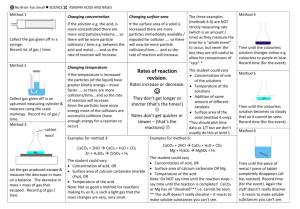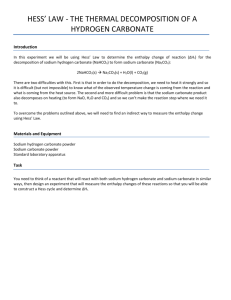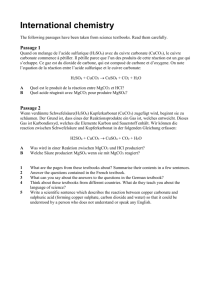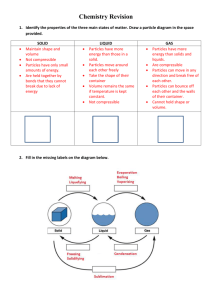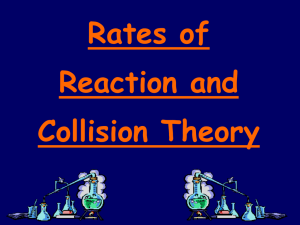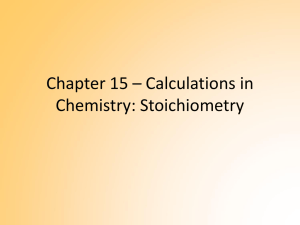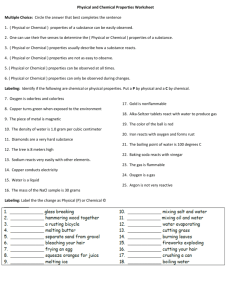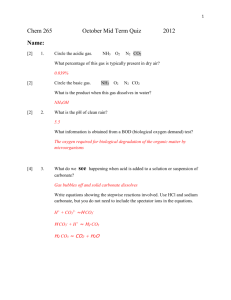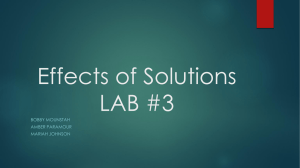Rates of reactions
advertisement
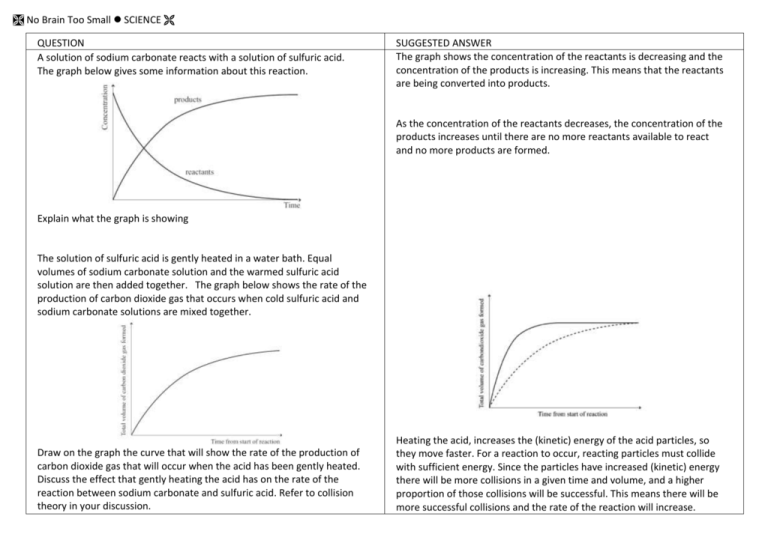
No Brain Too Small SCIENCE QUESTION A solution of sodium carbonate reacts with a solution of sulfuric acid. The graph below gives some information about this reaction. SUGGESTED ANSWER The graph shows the concentration of the reactants is decreasing and the concentration of the products is increasing. This means that the reactants are being converted into products. As the concentration of the reactants decreases, the concentration of the products increases until there are no more reactants available to react and no more products are formed. Explain what the graph is showing The solution of sulfuric acid is gently heated in a water bath. Equal volumes of sodium carbonate solution and the warmed sulfuric acid solution are then added together. The graph below shows the rate of the production of carbon dioxide gas that occurs when cold sulfuric acid and sodium carbonate solutions are mixed together. Draw on the graph the curve that will show the rate of the production of carbon dioxide gas that will occur when the acid has been gently heated. Discuss the effect that gently heating the acid has on the rate of the reaction between sodium carbonate and sulfuric acid. Refer to collision theory in your discussion. Heating the acid, increases the (kinetic) energy of the acid particles, so they move faster. For a reaction to occur, reacting particles must collide with sufficient energy. Since the particles have increased (kinetic) energy there will be more collisions in a given time and volume, and a higher proportion of those collisions will be successful. This means there will be more successful collisions and the rate of the reaction will increase. No Brain Too Small SCIENCE Loss in mass (g) QUESTION Marble is often used in experiments to help students understand factors that affect reaction rates. Marble is made up of calcium carbonate, CaCO3, which readily reacts with hydrochloric acid, HCl. A laboratory experiment involved adding 1.00 gram of marble chips to 10.0 mL of hydrochloric acid in test tube A and 1.00 gram of smaller marble chips to 10.0 mL of the same concentration of hydrochloric acid in test tube B. The rates of the two reactions are shown on Time (min) the graph. Discuss, in terms of particles, the effect of changing the surface area of the marble on the rate of the reaction. Include in your answer: • any observations you would make during this reaction • reference to the curves on the graph • a balanced equation. Magnesium ribbon reacts with dilute hydrochloric acid in a conical flask, which is connected to an inverted measuring cylinder in a trough of water. The volume of gas produced is measured over a few minutes, and the results are used to sketch a graph. (a) Explain why, in terms of particles involved, the line on the graph levels off over time. (b) What effect would replacing Mg ribbon with the sma mass of Mg powder have on the rate of the reaction? SUGGESTED ANSWER Test tube B will bubble faster than test tube A. The marble chips in test tube B will completely react with the acid, faster than the larger marble chips in test tube A. By changing from larger chips to smaller chips, the surface area of the marble / calcium carbonate has increased. The rate of the reaction between the smaller chips and hydrochloric acid is higher because there are more marble / calcium carbonate particles available to react with the acid (particles /H+/H3O+ in solution). Therefore more collisions will occur /unit time (more frequent collisions) and more successful collisions will result, causing a high rate of reaction. This rate of reaction will gradually slow down as the reactants are used up to form products. CaCO3(s) + 2HCl(aq) → CaCl2(aq) + H2O(l) + CO2 (g) (a) The reaction has stopped / slowed down / no more gas is produced. The reactants are being converted into products. This means there are fewer / no reactant particles available to collide as the reaction progresses. The rate of the reaction will decrease and eventually the reaction will stop. (b) The reaction rate will increase. There are more reactant particles immediately available to react because the surface area of the powder is greater than that of the ribbon. There is greater exposure of the magnesium particles so more can collide at any one time. This means there will be more (effective) collisions per second / more frequent collisions between the Mg / powder and the acid, leading to an increase in the rate of the reaction. No Brain Too Small SCIENCE QUESTION Draw a circle around the formula of each of the bases in the list below. H2SO4 SO2 KOH NaHCO3 HNO3 CaCO3 CO2 Discuss the characteristic properties of the bases you identified above In your answer: • Identify the pH of the bases as pH is less than, greater than, or equal to, 7. • Identify the effect of these bases on both litmus paper and universal indicator. • Describe the observations you would make for the reaction between TWO of these bases and dilute nitric acid. • Link the relevant chemical species to the observations you described. • Write TWO balanced equations. Discuss the acidity of the THREE solutions shown on the diagram above: battery acid, rain water and ammonia solution. Your answer should: • describe what colour you would see when each solution is tested with universal indicator solution • rank the solutions in order from least acidic to most acidic • discuss why each solution has a different pH. Discuss why the reactions of sulfuric acid, H2SO4, with sodium hydroxide, NaOH, and sodium hydrogen carbonate, NaHCO3, are both considered neutralisation reactions. Include in your answer: • a definition of a neutralisation reaction • any observations made during both reactions • why each reaction is considered a neutralisation reaction • any relevant balanced equations. SUGGESTED ANSWER KOH; NaHCO3; CaCO3 should all be circled Bases have a pH that is greater than 7. They turn red litmus blue and turn universal indicator blue, (indigo) and purple / violet (indigo). Feel soapy; Release OH- ions; React with acids; Neutralisation in reaction with acids; Proton acceptors ; Acid + Base Salt + water Metal hydroxides, metal carbonates and metal hydrogen carbonates are bases. They react with acids to neutralise them / form water. For example potassium hydroxide reacts with nitric acid to form potassium nitrate and water. KOH + HNO3 → KNO3 + H2O Sodium hydrogen carbonate reacts with nitric acid to form a metal salt, carbon dioxide gas and water. NaHCO3 + HNO3 → NaNO3 + CO2 + H2O Calcium carbonate reacts with nitric acid to form a metal salt, carbon dioxide and water. CaCO3 + 2HNO3 → Ca(NO3) 2 + CO2 + H2O Battery acid has a pH of zero, rainwater has a pH of 6.3 and ammonia has a pH of 11.5. This means the ammonia solution is the least acidic solution, then the rain water and then the battery acid is the most acidic. When tested with universal indicator solution, the battery acid turns universal indicator red, rain water turns it green/yellow-green and ammonia turns it blue, indigo. The battery acid has a very low pH of zero because the acid has largest numbers of H3O+ /H+ ions in solution. Rain water has a pH of 6.3, so its pH is almost neutral, it has a low concentration of H3O+ /H+ Ammonia is the least acidic solution with a pH of 11.5. It will have the lowest concentration of H3O+ /H+ of the three solutions, or high OH–. A neutralisation reaction occurs between an acid and a base and one of the products is water. The resulting pH of the solution is neutral, pH = approximately 7. Sodium hydroxide and sodium hydrogen carbonate are both bases. When sodium hydroxide reacts with sulfuric acid, it produces a salt and water. There are no obvious observations for this reaction (you may detect an increase in temperature). 2NaOH(aq) + H2SO4(aq) → Na2SO4 (aq) + 2H2O(l) When sodium hydrogen carbonate reacts with sulfuric acid it produces a salt and water and carbon dioxide gas. You would see and hear fizzing in this reaction. 2NaHCO3 + H2SO4 (aq) → Na2SO4 (aq) + 2H2O(l) + 2CO2 (g) No Brain Too Small SCIENCE
